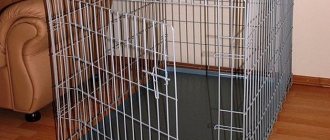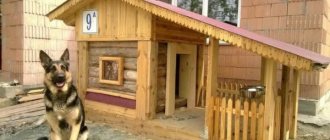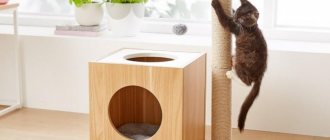Why doesn't my pet go to the kennel?
There are several reasons why a dog may ignore the kennel:
- The smell of another animal. If the dog inherited the kennel, he will almost certainly prefer not to enter “foreign territory.”
- Another unpleasant smell. Due to its keen sense of smell, the dog will experience severe discomfort if one of the elements of the kennel or bedding turns out to have a strong odor (for example, due to paint or detergent).
- Closeness. If the animal is already accustomed to living with its owners in a house or apartment, the new housing will in any case seem very small to it.
- Breed characteristics. There are dog breeds that, in principle, are not intended for street keeping. So, if a guard dog feels at home in an enclosure, then a companion dog, “exiled” to the street, will perceive this all his life as an unfair punishment, which will result in depression, embitterment and distrust of people.
However, guard dogs may also have their own preferences: for example, a good view of the territory is important for Caucasian Shepherd dogs, and if the yard is poorly visible from the booth, such a dog will prefer to spend the night in the snow, but in a place where the area entrusted to it will be clearly visible.
>Video “How to train a dog to crate?”
From this video you will learn how to accustom a dog to a kennel or crate without psychological trauma for the pet, what methods are used for this.
What should you not do during relocation?
When moving to the kennel, you should not do the following:
- Forcibly driving into a booth will scare the animal.
- Leave your pet in a new place for a long time during the first days of adaptation.
- Move the kennel from place to place. This can cause stress and refusal to enter it in a new place.
- Overindulge. Take precautions in everything.
- Use an enclosure as punishment.
Video: how to train a dog from an apartment to live in the yard?
How to properly furnish a new home
It is advisable that the booth be located opposite the entrance to the house - this way the dog will be able to see its owners more often. It should not be located in a low area, otherwise water will flow inside due to rain or melting snow. For additional protection against flooding, you can place it on small supports.
There should not be a barnyard, garage, workshop or other structures with strong odors nearby.
It is important to choose the correct dimensions of the structure. The animal, sitting inside, should slightly touch the ceiling with the tips of its ears, and, if desired, be able to stretch out to its full height on the floor. If the structure is smaller, the dog will feel cramped and uncomfortable, and a dwelling that is too spacious may freeze in winter.
Many dogs like to sit on the roof, so it is advisable to make it with a slope of no more than 10 cm. It is advisable that it be removable or folding - this makes cleaning easier.
The entrance hole should be slightly lower than the dog’s withers in height and 2–3 cm higher than the width of its shoulders. It is advisable to have a sun canopy over the entrance.
A puppy kennel is made with a reserve, focusing on the dimensions of an adult dog.
The design must be protected from leaks and drafts, otherwise the pet will not only feel uncomfortable, but may also get sick.
The roof needs to be covered with roofing felt. All boards should fit snugly against each other. It is desirable that they be pine. It is best to make double walls, and lay foam or felt between them. Sand the wood thoroughly to ensure no splinters remain. Do not use paints or varnishes with a strong odor.
The floor should also be thick, dense, and protected from freezing. Cover it with straw, cover it with a tarpaulin, and lay bedding on it, which has already been used before and smells like a dog.
Why does a puppy need an enclosure?
Each puppy has a different personality, but they are naturally curious and active.
At a young age, they are not yet accustomed to commands and are not adapted to living in an apartment. Left unattended, animals can damage expensive items and harm their own health. In addition, the puppy has yet to learn how to relieve its natural needs outside the home. A puppy enclosure for an apartment is a great way to save yourself from all these problems. He assists the owner and protects the animal from dangers in the house:
- the puppy is in a safe space and cannot cut himself or swallow inedible objects;
- the owner can do household chores without worrying about the pet;
- the floor and carpets remain clean if you place a diaper in the enclosure;
- the possibility of keeping the dog in isolation if there are suspicions of any disease or if it is in quarantine.
The puppy's enclosure must be made of durable and safe material. If an animal escapes from an open enclosure, it is worth improving the design and adding a lattice roof.
Rules and secrets of training
It is important to carry out training gradually. To begin, show the dog the booth and allow him to explore it calmly. Place your dog's favorite toy or treat inside to give him an incentive to enter.
The first time you can keep your dog outside for about an hour. Don't leave her alone, praise her and give her a treat when she comes into the booth on her own.
Every day, increase the time your dog spends outside the house by about an hour. Since in this case the booth will be the only refuge available to him, he will gradually get used to it.
You should only take your pet home during severe bad weather. If the rain is light, it’s okay - the dog will just have the motivation to sit in the kennel.
All dog toys should now be kept only outside or in the kennel. The feeder should also be placed next to the new housing, and the diet can be made more tasty during the training period. Praise your dog regularly when he enters the kennel on his own.
Dog handlers advise placing a ticking clock in the booth or next to it (if there was one in the house). A warm water bottle is also believed to calm dogs.
After some time, when the dog spends a sufficient amount of time in the kennel without showing fear or depression, you can leave him there to sleep all night.
Please note that it is much easier to house train a dog in the spring or summer. In autumn and winter, cold and bad weather will create additional discomfort.
Is it possible to keep huskies outside?
Keeping a husky outdoors is the most suitable option for representatives of this breed. The two-layer wool cover can withstand temperatures down to - 30 ° C. Therefore, your pet will be able to stay outside all year round.
Husky is an active and agile breed that requires special attention in development.
What are the functions of an enclosure and a kennel for a husky?
In a private home, a dog can be kept either on a chain in a kennel or in an enclosure. But there are many opponents of the first method. Huskies do not tolerate restrictions in space. If, after all, the dog is placed in a kennel, the chain should be as long as possible. The pet must be allowed to run regularly.
The best way is to keep them in an enclosure. The dog will be able to spend his energy, he will have the opportunity to play at any time of the day.
For your information! Huskies kept on the street have a stronger immune system than representatives of this breed living in an apartment. They have thick and shiny fur. The owner needs less time to walk the pet.
But this method of keeping also has its downside - the dog may experience a lack of communication.
An enclosure for a husky eliminates the problem of a splash of energy
How to choose the right place
The dog should not be disturbed by loud noise, so the place for the enclosure should be away from the road. It should be smooth and dry so that moisture does not accumulate there in rainy weather. It is recommended that part of the enclosure be in the shade. This is necessary so that the dog can cool down in the summer.
How not to turn a cage or enclosure into a prison: training your dog correctly
Is your dog howling, whining and scratching in his crate or enclosure? She doesn't want to stay there and is reluctant to go inside? This is a sure sign that when getting to know the new premises, you, without knowing it, instilled in your pet the attitude: “this is a prison, and you are a prisoner there.” How to make the introduction correctly and get a happy dog lying peacefully in its place - read further in our material. Make sure your pet shows interest. First, understand what your dog prefers: playing or eating. If the former, you'll need her favorite treat. If the latter, it is the most long-lasting and valuable toy for a domestic animal.
The process described below is equally suitable for both crate and kennel training:
- Play a prank on the dog or let him know that you have something to eat;
- When your dog is interested, throw a treat/toy inside the cage or enclosure;
- Has the desire to get inside been identified? Praise the dog vigorously, even if it has only approached the desired goal (walked up or put at least one paw);
- Most likely, your dog either never dared to get his treasures, or quickly ran inside and jumped out like a bullet. Don't despair, everything is going according to plan;
- Be patient, don't stop after a dozen attempts. When the dog begins to climb completely, reinforce the action with a command (for example, “Place”).
Note for crate training. If you are crate training your dog in the house, first get him used to his own place. Buy a mat and praise her when she lays on it. Reinforce the dog's action with a command. This way, when you decide to move your dog's crate, it will be much easier to do so. The main thing when introducing a dog to a new place for the first time is not to scare it or associate the new space with negativity. Some dog lovers literally push their pet inside, like the police ramming rowdies into a bullpen. Moreover, as soon as the dog misbehaves, he is immediately roughly shoved into a cage or enclosure. Don't repeat this mistake. When a dog is in its place, it should absolutely not be scolded. On the contrary, when she runs into her “hole,” immediately stop any punishment. Weakness of spirit, you ask? No, it’s a banal trick: by doing this you let the dog know that lying in a cage/enclosure means being completely safe. Children should not bother her there, there should be complete peace. However, you should not resort to this trick intentionally, starting to get angry with the dog literally because of every uneven swing of its tail. A note for crate training. If you most likely will not fit in the cage, then the enclosure gives you the opportunity to personally climb inside and lure the dog with a toy or treat. Play there, do something interesting, do it regularly, and the dog will understand that entering the enclosure means receiving positive emotions.
When and for how long should you start closing the cage/enclosure.
At first, you can remove the door altogether, as the dog needs to get used to it. Let him come and go as he pleases. Closing it ahead of time means scaring your pet and throwing away all your efforts.
Move feeding exclusively to the enclosure/cage - let food intake be associated with this place. Leave the door open for the first week, then start closing it while your dog is eating. It is better to start leaving it locked from one minute, increasing the interval as carefully as possible. A jump from two minutes to twenty minus is already a stressful situation. Howling or scratching? Be calm and decisive: this behavior is unacceptable. Give a treat and only let your dog out when he calms down. Otherwise, you can turn your pet into an angry buffalo, which again and again rushes to the exit, ramming it, and thereby awakening the owner’s desire to immediately open the door. Offer the dog another scenario: “you sit quietly - I let you out or give you a treat.”
When your furry friend begins to sit quietly in place for about 10 minutes, you can leave the room (in the case of a kennel, simply hide from the dog’s sight) and leave him alone. The likelihood of barking, whining and rioting increases by 2 times, so initially leave for literally half a minute. Then increase the time you are away. Your main helpers are consistency of actions and confidence in yourself and the result. Note: ignore the dog if it whines, howls, barks or scratches, otherwise you will instill a clear stereotype: “rebellion is salvation.” How long can you leave a dog in an enclosure or cage? A 3-4 month old puppy should not be locked in for more than an hour. 4-6 month old – no longer than 3 hours. An adult dog may well be waiting for you to come home from work for the entire 8 hours. Note. Do not leave your dog in a crate/kennel for 16 hours, that is, overnight plus the entire work day. In this case, there can no longer be any talk of any love for one’s place. Provide her with at least an hour and a half morning walk. The cage should not scare Sometimes the reason for the fear of the cage is not the actions of the owner, but some of its features. For example, a tray may rattle unpleasantly when a dog steps on it with its paw. For some dogs, this is no less a cause of discomfort than for you - a creaking sofa with springs protruding from it. Do not forget that the size of the cell should be such that:
- Its length was equal to two animal bodies;
- Its width was equal to one and a half dog bodies;
- The height should be such that the dog can stand comfortably and there is still free space above his head.
Let us emphasize the main aspects of training a dog to an enclosure and a cage:
- Do not push your dog inside with physical force;
- Do not scold her when she is in a cage/enclosure, let the animal have a space in which no one bothers him;
- Feed your dog only there;
- Cover your dog for no more than a minute at first to avoid stress;
- Associate the aviary/cage with receiving treats and pleasant experiences
Has your dog already had a negative experience with a cage or enclosure and categorically refuses to stay there? You can use the services of our canine center. Specialists will arrive at a time convenient for you and help train your dog. We work in Moscow and the Moscow region
How to accustom a puppy to an enclosure after an apartment
How to choose an aviary?
• The enclosure must be chosen so that the dog cannot jump over the fence, dig under or crawl between the bars. • The entire area must be visible from the enclosure. • The fence must have a kennel under a canopy so that the dog does not feel hot in it and wants to be there. • If the enclosure is intended for a large dog, but it has not yet grown and crawls between the bars, it should be fenced with a regular net - this way the puppy will not be able to get out into the wild, but will see everything. This is extremely important for the development of a normal dog’s psyche.
To teach a dog to any command, for example, “How to teach a puppy to use the toilet outside?”, the main thing is consistency. You can’t lock a dog in a cage for one hour once a week and wait for results - they won’t come. The dog will begin to feel as comfortable in the enclosure as outside it only if it considers this place comfortable for rest. A puppy will never enter an enclosure if it has bad memories associated with it. Therefore, it is strictly forbidden to scold a dog in an enclosure or shout at it to stay there. Such actions will not lead to anything good. What needs to be done is to convince the dog that the enclosure is its personal territory where it can eat, sleep and relax.
What to remember?
It is important to accustom your dog to a kennel in the yard and not leave it in a dark home. The dog may get scared. But once a phobia develops, it is quite difficult to cure. During the training process, weather conditions must be taken into account. If it starts to rain, the pet will subconsciously take refuge from the weather in a shelter. If the heat outside is unbearable, then the animal will not want to be in a stuffy “room.”
The next step is to accustom the dog to the chain. First of all, it is necessary to let the animal get used to the new territory and only then teach the guard to be on a chain. It should be taken into account that if the baby’s parents have lived their entire lives in an apartment, then adaptation to a “private dog house” will be extremely difficult.
To accustom a puppy to an enclosure or a kennel after an apartment, you need to place his favorite things inside the home. The dog should be rewarded with his favorite treats for staying inside the house for a long time. Motivation and patience are the key to success.
A training video on how to accustom an adult dog or puppy to a new home on the street, to a kennel that will become a comfortable and reliable refuge for him, will help the owner understand all the intricacies of this science.
How to accustom a puppy to an enclosure video:
Aviary
• When the puppy is still very small, it is necessary to bring it into the enclosure every day, saying the command “place”. It is advisable to do this after the dog has eaten, walked, played enough and done its business. Since young dogs sleep a lot, there is a high chance that the puppy will fall asleep in the kennel. But even if this does not happen, and he immediately runs out after you, do not scold him. Just do the same procedure again a little later. • It is recommended to place the dog’s bowl and water container in the enclosure so that the dog quickly adapts to this area. • Do not cover a very small puppy. Keep the fence open at all times so that the dog can enter and exit without hindrance (and if there is water in the enclosure, he will enter it quite often). • When the puppy has already grown a little, you can begin to close it in the enclosure for a short time. But again, the dog must be fed, walked and exhausted with games so that it has no other desire than to rest in the shade of the booth. The older the dog, the longer the period of time it is closed until the required number of hours is reached.
Attention: the dog should be in the enclosure no more than 12 hours a day, otherwise it will develop mental disorders. She will perceive being in the enclosure not as a rest while waiting for the owner to be free and come to play with her, but as a punishment. The dog will feel lonely and abandoned.
How to kennel train an adult dog?
An adult dog, like a puppy, can be crate trained with the help of treats. This is done as follows: you need to show the dog a treat, and then throw it into the open enclosure, accompanied by the commands “take” and “place” when the dog is already in the enclosure. After several repetitions, the dog will no longer want to leave the enclosure.
Aviary for a puppy
It is important to use treats that are natural and healthy for the dog. You cannot give your dog small bones as this kind of reward, because while waiting for the next portion, he will swallow them almost without chewing, which is not entirely healthy for the body. Therefore, for treats, you should use something light and soft, such as chicken or cheese.
Based on all that has been said about how to accustom a puppy to an enclosure, we can assume that any dog can be accustomed to an enclosure with proper and consistent training, but is this true?
There are a number of small and medium-sized breeds that absolutely cannot be kept in an enclosure. These include Chihuahuas, cocker spaniels and terriers due to their love of freedom and love. For these breeds, it is extremely important to constantly be near the owner, since otherwise it has a bad effect on their psyche. Also, you cannot keep an American Hairless Terrier or other dogs without hair in an enclosure. Even if you install a heated enclosure, such dogs will feel uncomfortable in it.
Aviary for a puppy
If you don’t know “How to teach a puppy to commands?” or “How to train a puppy to use a leash?”, then this is just for you!
How to train a dog to a kennel: important points
There are often cases when a dog refuses to enter the booth for unknown reasons. Do not be offended or punish your pet, do not try to force the dog into the kennel. Sit down and think about why the animal behaves this way.
The most common reason is that the dog previously lived in an apartment. She got used to the warmth, spacious room, and constant presence next to her owner.
For a long time the animal was in the center of attention, and then everything abruptly gave way to alienation and loneliness. It is important to understand that accustoming a dog to a new home should proceed gradually, unnoticed by your pet.
To begin with, place your pet in a kennel for a while, but let him spend most of the day in his usual place (house, apartment). Increase the amount of time the dog spends in the kennel every day, and soon the pet will fully adapt.
We suggest you read: How many grams of food to give a puppy rules and regulations
how to train a puppy to use a leash and collar
How not to turn a cage or enclosure into a prison: training your dog correctly
Is your dog howling, whining and scratching in his crate or enclosure? She doesn't want to stay there and is reluctant to go inside? This means that when getting acquainted with the new room, you unwittingly instilled in your pet the attitude that this is not a new VIP box for the best dog in the world, but a room of fear and panic. How to make the acquaintance pleasant and get a happy dog lying peacefully in its place - read on.
In this material we will use the word “cage” to avoid confusion, but the recommendations are also suitable for training a dog to be in an enclosure.
An easy way to whet your dog's interest in the crate
Some dog lovers begin to act on the principle of “tolerate and fall in love” and push the dog into a cage, just as the police force rowdies into a bullpen. As a result, the animal begins to be afraid. And this can even result in aggression towards the owner. Don't repeat this mistake - get your dog interested. This simple diagram will help you:
- Play a prank on the dog or let him know that you have something to eat;
- When your dog is interested, throw a treat/toy inside the crate;
- Has the desire to get inside been identified? Praise the dog vigorously, even if it has only approached the desired goal (walked up or put at least one paw);
- Most likely, your dog either never dared to get his treasures, or quickly ran inside and jumped out like a bullet. Don't despair, everything is going according to plan;
- Be patient, don't stop after a dozen attempts. When the dog begins to climb completely, reinforce the action with a command (for example, “Place”).
- Success is when you open the door, and the dog does not rush out like a rocket, but remains in the cage. But don't forcefully hold her.
What to use in the process – a treat or a toy – depends on the dog’s motivation. Simply put, you must understand what she likes more - eating or playing.
Note. If you are crate training your dog in the house, first get him used to his own place. Buy a mat and praise her when she lays on it. Reinforce the dog's action with a command. This way, when you decide to move your pet's crate, it will be much easier to do so. In the case of an aviary, the analogue is a booth.
Associations play a major role. The following advice in the box often helps not only to accustom your dog to the crate, but also to develop warm feelings for him.
A note for crate training. If you most likely will not fit in the cage, then the enclosure gives you the opportunity to personally climb inside and lure the dog with a toy or treat. Play there, do something interesting. Do this regularly, and the dog will understand that entering the enclosure means receiving positive emotions.
When and for how long should you start closing the cage/enclosure?
The main thing is to take your time. When you associate the crate with positive emotions, the dog will show more interest in it: it will study it, go in and out 100 times a day. Make entry free.
Note. If your dog ignores the crate even though he's willing to go inside, you can leave treats there. This will encourage the animal to regularly visit its place.
Move feeding exclusively to the cage - let him associate food with it. Start closing the door from the second week - at first literally 60 seconds will be enough.
Howling or scratching? Don't react! Let your dog out and offer a treat when he calms down. Otherwise, you can turn your pet into an angry buffalo, which again and again rushes to the exit, ramming it, and thereby awakening the owner’s desire to immediately open the door. Offer the dog another scenario: “you sit quietly - I let you out or give you a treat.”
When your furry friend begins to sit quietly in place for about 10 minutes, you can leave the room (in the case of a kennel, simply hide from the dog’s sight) and leave him alone. The likelihood of barking, whining and rioting increases by 2 times, so initially leave for literally half a minute. Then increase the time you are away. Your main helpers are consistency of actions and confidence in yourself and the result.
Note: ignore the dog if it whines, howls, barks or scratches, otherwise you will create a clear stereotype in its head: “rebellion is salvation.”
Four popular mistakes that are best avoided
- The cage is used as punishment. In this case, achieving normal animal behavior in a cage without squealing and trying to get out is unrealistic. Because the biggest mistake has been made - the cage is associated with punishment;
- Opening the crate when the dog is excited and banging on the door. Usually in initially unsuccessful attempts to calm her down. This was mentioned above in the text.
- Inappropriate requirements for the dog. Do not leave your dog in a crate for 16 hours, that is, overnight plus the entire work day. In this case, there can no longer be any talk of any love for one’s place. Provide her with at least an hour and a half morning walk.
- Choosing the wrong cage. For example, a tray may rattle unpleasantly when a dog steps on it with its paw. For some animals, this is no less a cause of discomfort than for you - a creaking sofa with springs protruding from it. Do not forget that the size of the cage should be such that: Its length is equal to two dog bodies;
- Its width was equal to one and a half dog bodies;
- The dog could easily stand up to its full height and there was still free space above its head.
Bottom line
Let us recall the main aspects of crate training a dog:
- Do not push your dog inside with physical force;
- Don't scold him when he's in the crate - let the dog have a space where no one bothers him;
- Feed your dog only there;
- At first, close the door for no more than a minute to avoid stress;
- Associate the crate with receiving treats and pleasant experiences.
It is quite difficult to train a dog from an apartment to live in the yard. You need to be patient, as the animal may be afraid of the new environment and may not want to stay in the kennel.
However, with the right approach, positive results can be achieved in a few weeks.
Basic requirements for housing on the street
To arrange a new home for a dog, you should adhere to the following rules:
- Make the enclosure or kennel spacious, clean, darkened, and well ventilated (no drafts). The height of the viewing opening should be approximately 75% higher than the length from the animal's shoulder to the ground.
- The door is made using a piece of rubber, tarpaulin, with cut longitudinal strips with weighted ends. This will allow the dog to see what is going on outside and stay inside.
Breeds with thick coats and short muzzles are more sensitive to heat exhaustion. A home that provides sufficient shade and optimal flow of fresh air will suit them.
Providing a safe place is important, especially if the dog lives on the street and will spend long periods of time there. A properly built kennel can protect a dog from extreme temperatures, wind, rain, snow, and potential predators.
There are two types of enclosures:
- Open – a fence installed around the sleeping area. The structure will be useful for limiting the pet while guests arrive.
- Closed - with a roof, mesh walls, doors. There is a kennel inside.
It is recommended to lay a floor in the room reserved for the dog for additional insulation. Usually it is made of concrete (with wooden flooring) or asphalt, and also inclined so that puddles do not form during washing and after rain.
Experts recommend covering the roof with bitumen shingles (to protect against rain or hail).
The doors of the enclosure must open inward and be strong. It is better to choose a strong lock (so that the dog cannot knock it out).
General requirements for outdoor enclosures:
| Dog height | Room area |
| More than 65 cm at the withers | 10 m² |
| 50-65 cm | 8 m² |
| Up to 50 cm | 6 m² |
Training methods
Expert opinion Anna Abramenko An avid dog lover. Experience in veterinary medicine since 2009. Ask a Question
It is not easy to train an adult dog to stay in a kennel. If she won't go to the kennel, the following tips will help solve the problem.
- The animal needs to be allowed to get used to it, allowed to enter a new booth, sniff the surrounding area, and wait until it gets used to the enclosure. To do this, you should gradually leave the house with him in dry, warm weather and introduce him to his future home.
- When a dog enters a new home, it is important to reward it with a treat to develop pleasant associations.
- It is worth putting several of your favorite dog toys in the kennel so that the animal can feel a familiar smell.
- When the dog is in the kennel, it is important not to forget about it and not leave it alone. A simple game and communication will reinforce positive emotions.
- It is better to accustom an animal to a new place in warm weather, since in winter being outside can become stressful for him.
The kennel or enclosure is placed facing the front door so that the owner, if necessary, can quickly assess the dog’s condition.
Basic recommendations
- You cannot leave a dog (especially a puppy) locked in a dark booth. The animal will become frightened and there will be a risk of developing a phobia, which will be extremely difficult to eradicate in the future.
- Do not rush to put the dog on a chain, give it the opportunity to familiarize itself with the area surrounding the new home. As practice shows, this stage takes the most time. The pet will begin to run around the yard, frantically examining and sniffing everything around.
- Weather plays an important role in the process of house training a dog. During heavy rain, the animal on a subconscious level will want to hide from it, so it will climb into a new house. If the weather is hot, the dog, on the contrary, will not want to sit in a stuffy booth, so he will get out. Based on the above.
- The primary stage in training a dog to a booth is comfort and “native” things. Place your pet’s favorite toys and bedding with its scent in the home. Place a bowl of food and drink in an accessible area.
- Motivate the animal in every possible way. When you put him in the booth, give him a treat and reward your pet for staying in the house for a long time. Stroke him, play with him, speak in a calm and gentle voice. It is important to initially establish the association that a new home brings only pleasant sensations.
- At first, when the dog is in the kennel, do not leave it alone. Go out into the yard every time, spend time with your pet, don’t forget him. Avoid prolonged whining to avoid damaging the animal’s psyche.
- As mentioned earlier, take things one step at a time. First, place your pet in the kennel for 1 hour, while carefully monitoring his well-being. The next day, increase the time to 2 hours, breaking it up into several intervals. Add time with each passing day, but do not put your dog in a kennel for 5 hours or more at once. The process should proceed unnoticed.
- When house training your dog, focus on tasty food. For example, treat your pet to meat or meat porridge, or give chicken broth. Buy special treats at the pet store. Convey to the animal that the booth is, first of all, a good mood, well-being and constant satiety. Don't let your dog go hungry.
- If possible, choose early spring or autumn to housetrain your pet. In winter and late autumn, when it rains or snows, the animal will feel uncomfortable and will want to be close to its owners in a warm apartment/house.
- A pet’s adaptation to a new kennel directly depends on what its parents are like. If the older generation has spent their entire lives in a house or apartment, puppies will also have difficulty adjusting. In cases where the parents of the offspring live on the street, the kids adapt much faster. The familiar and natural environment will do everything for you.
- Position the booth in such a way that the window in it looks onto the porch, or more precisely, at the front door of your house. You will go outside, at which time your pet will feel comfortable. In addition, you can always look out and assess the general condition of the animal.
We suggest you read: Command place, how to teach a dog the command place
Before placing your pet in a kennel, give it a good home. Use only high-quality, dry materials free of foreign odors and mold; if possible, avoid varnish coating. Place your dog's favorite toys and scented bedding in the kennel. Place bowls of food and water nearby. Increase the time spent in the new home gradually (by 1 hour every day), play with your pet and visit him more often.
how to train a dog to toilet outside
Arrangement of the booth
First, choose the material for the kennel: wood, metal, plastic. Plastic buildings are usually lighter and cheaper. They are quite easy to transport, they do not rot, do not require painting, and are easy to wash.
Wood buildings are stronger, more durable, and a better insulator than plastic, so your dog is less likely to overheat inside the kennel. But wood has one significant drawback - rotting.
In addition to plastic and wooden ones, there are also iron booths. They are durable, easy to care for, but uncomfortable and bulky.
The roof of the booth must be strong and airtight.
You should definitely consider ventilation; for this you can put the kennel on a pallet or legs.
It is better to choose polystyrene foam as room insulation. They are easy to use, lightweight, and have high thermal insulation properties. Felt is also used instead: it is durable and has good vapor permeability.
The bedding for the booth should not be too large or small. The material is also important for her. Blankets, towels, carpet, hay, straw, and newspapers often become moldy. Fleas and bedbugs will live in them.
The best bedding option is pillows filled with cedar shavings, as the oil from this tree will repel insects. However, it can cause allergies in dogs. To minimize this possibility, fill a small bag with cedar shavings and place it in the kennel to repel fleas and bedbugs.
When training a dog to a booth or enclosure, dog breeders should not carry out the following actions:
- Forcing your dog into a kennel, as this will only scare him. It is better to slowly, carefully find out what caused this behavior.
- Overwork, force you to repeat the “place” command. It is advisable to gradually increase the intervals of stay in the booth, and the rest of the time to give the animal freedom.
- Overindulge. Everything needs moderation.
- Punish inside the kennel, force the pet into the enclosure.
Why train a dog to a chain?
From the very beginning, the owner must understand why he should accustom his pet to a chain. If the dog’s main task is to bark at strangers and scare them away, then it would probably be more humane to equip the yard with a video surveillance system with an alarm. And a dog, which will be severely limited in its movements around the territory, will not be able to protect it properly. If your dog just sits on a short chain, he will not become a hindrance to intruders who set themselves the goal of breaking into the house. When leaving your house unattended, do not expect a dog on a chain to protect it. Attackers often poison chained dogs to carry out their dirty deeds. And for such dogs, packs of stray dogs roaming freely pose a danger. Therefore, in attempts to drive away strangers, animals on chains sometimes strangle themselves with their own chains.
If your goal is to raise a real guard dog, then you will have to put a lot of effort into this. The dog must distinguish its own from strangers and obey commands unquestioningly. And in this case, there is no need to train the dog to sit on a chain all the time. You will need to tie him up only when guests come to you, other people who will be unpleasant to see the dog barking and running after them. And in order for your student to be calm about temporary deprivation of liberty, he must be raised correctly.
Rules for training a dog to a chain
It is worth mentioning that the ancestors of dogs were wild animals that lived freely. Therefore, the instinct, the craving for free movement is transmitted to these domestic animals. It is for this reason that depriving a dog of its freedom is in some way violence. And you need to act diplomatically in the process of accustoming to the chain. The first rule is gradualism. First, the dog must sniff the territory and get used to walking on it. Accustom the puppy you bought to such walks soon after purchase. Bring the dog to the booth, give him the opportunity to sniff everything, you can even try it with his teeth. That is, first the dog remembers the territory of the yard and gets acquainted with the smells. They should become family to him. He should also get used to the booth. During this habituation, you should always be with your dog. The puppy will feel more confident this way. Then you should place a bowl with the puppy’s food next to the kennel and lay a rug inside. Let the dog lie there in your presence and eat on the street. And only after getting used to the kennel can the dog be put on a chain. Please note that this device should not be too short. The chain should allow the dog to move freely. When tying an animal for the first time, you should talk to the dog, stroke it, and call it by name. Let him sit on the chain for 10-15 minutes first. You are nearby, in his field of vision. Be sure to give your dog his favorite treat.
The next day, increase the time your pet is on a leash. But leave him alone, and hide or leave. If he starts barking a lot, then raise your voice and thus calm the dog down. After 3-4 days, leave the dog on the chain for several hours. But at the same time, there should be a bowl of food and water near her. And only after a week of chain training can you leave the dog there overnight.
Please note that a tethered dog will be more aggressive. Therefore, try to keep him in captivity less and give him the opportunity to move freely.
Perhaps in the first days the dog will whine, howl, and scratch. But do not give in to requests for mercy and teach that the dog must obey its owner. After free movement, the dog should come to you on the command “come to me” and calmly allow itself to be tied with a collar to the chain again.
There should be nothing on the ground near the dog that it could get entangled in. Spend time with your student more often during the first adaptation period. Walk with him and communicate, play and train him. Let him know that you love him just the same and that he is not alone. As a rule, psi of service and guard breeds quickly get used to a leash. Even court terriers, if properly trained, behave calmly on a chain after two weeks and get used to it.
Homemade
Indoor kennels are less popular and their existence is sometimes puzzling. But you can’t do without them if:
- the dog living in the apartment has puppies;
- for a newly arrived puppy in the apartment
- other animals or children appeared in the house where there is a dog;
- there is a lap dog living in the house;
- you are planning to go outdoors with your pet.
For puppies
A dog that has just given birth needs a cozy and secluded place. She can lie down in it without worrying about the safety of her puppies. At first, the latter will also need a quiet place that separates them from the still unfamiliar, huge and scary world.
When the puppies grow up a little, the owner will already realize the need for an indoor enclosure. The fact is that growing kids are extremely active, they love to try everything, and can create a lot of destruction in the apartment.
An enclosure will also be useful when toilet training fools - many recommendations on how to do this begin with the words “Place the puppy in the enclosure.”
Pets are jealous of their owner's attention - they love him devotedly! But sometimes this jealousy can become dangerous, especially if you have a defenseless kitten, another puppy or child at home. The animal will likely become nervous and protest. To help all family members adapt to the new situation, it is worth setting up an enclosure for a while.
For small dogs
Placing a small lap dog in an enclosure on a permanent basis is an excellent solution. After a while, the dog will get used to having his own house, with food, a bedroom and a place for a toilet. This way he won’t pee in the corners and disturb the owner’s sleep, and he won’t do any mischief in your absence. For games, and upon returning home, you can always release it.
A home enclosure for a small dog doesn’t have to be super expensive: you only need 2,000 rubles maximum and 2-3 hours of free time!
A portable enclosure will be needed if you are planning a picnic with your pet. The fact is that domestic dogs in nature can become confused and either run away or fall into a stupor from fright. To save yourself and your pet’s nerves, introduce him to the world around him gradually: within the enclosure.











